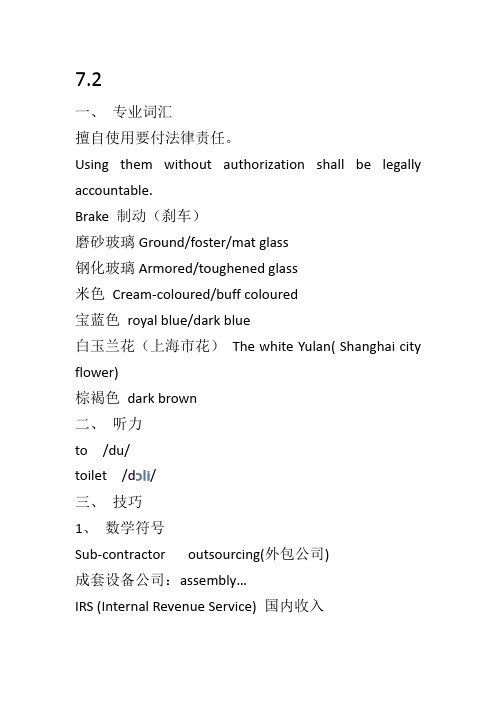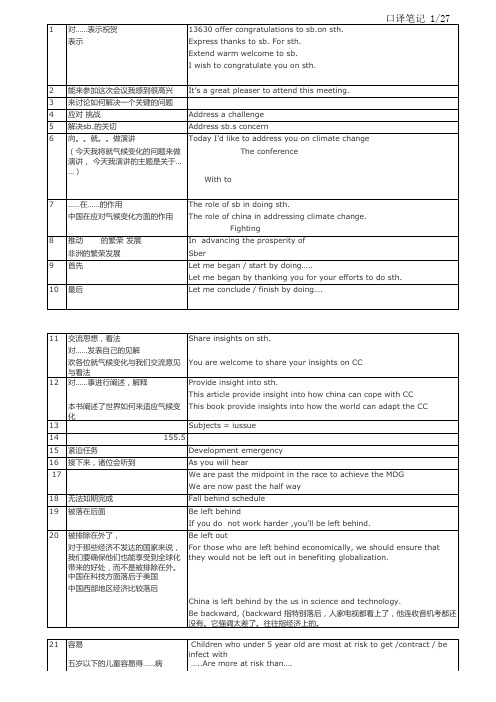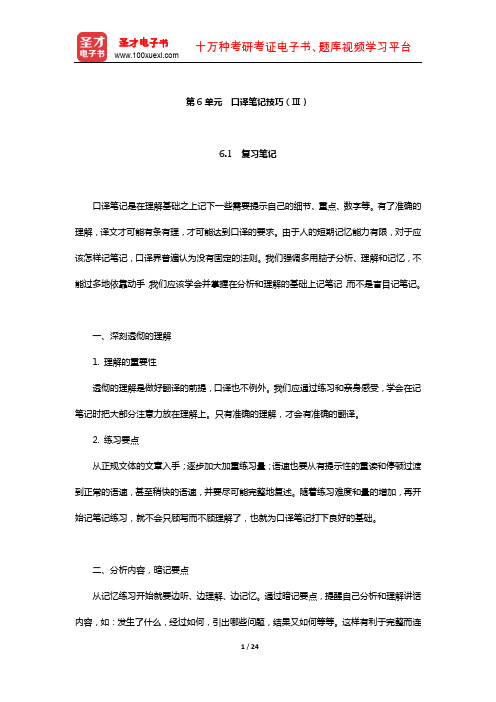英语口译笔记方法(3)
英语 口译笔记

7.2一、专业词汇擅自使用要付法律责任。
Using them without authorization shall be legally accountable.Brake 制动(刹车)磨砂玻璃Ground/foster/mat glass钢化玻璃Armored/toughened glass米色Cream-coloured/buff coloured宝蓝色royal blue/dark blue白玉兰花(上海市花)The white Yulan( Shanghai city flower)棕褐色dark brown二、听力to /du/toilet /dɔli/三、技巧1、数学符号Sub-contractor outsourcing(外包公司)成套设备公司:assembly…IRS (Internal Revenue Service) 国内收入Defense Secretary 外交部长Auto Show=Automobile Industry Exhibition (汽车工业展)2、缩写市政府Municipal People’s Government复婚remarry大力发展generositySS 社会制度CT 文化传统WPD 世界和平发展I’d like to thank sb for kind invitation/thoughtful arrangement/gracious hospitality欢迎某人上台Please join me in welcoming sb onto the stage.We’re very please to have sb with us.3、政治、新闻4、come all the way, 远道而来Conference(文科类的会议)Symposium(理科类的、科技类的研讨会)Seminar (研讨会)Forum (论坛)E.g. … on IT Shanghai 2011 上海2011(国际研讨会)7.9一、口译的Topic应对之策之一:1、Comparison Today I’d like to talk about …2、Opinion Some people thing …3、Other Others believe …4、My opinion …二、口译的Topic应对之策之二:1、Comparison Today I’d like to talk about …2、Achievements3、Problems existing in this field4、Solution三、口译的Topic应对之策之三:1、Comparison Today I’d like to talk about …2、Achievements3、Advantages of doing sth.4、Solution四、Communication1、EQ (Emotion quotient) IQ (intelligence quotient)2、Job vacancy/opportunitiesClear up misunderstandingPromote friendship3、educational background4、healthcare (medical professionals, cities)5、science, technology, pollution6、family, marriage, divorce五、日常知识Tap tops 手提电脑岗前培训:Pre-employment trainingPersonality training 仪表仪容培训进修:Further study儿童医学Pediatrics亲和力winning personality影响shape (customer requirement)“非常好的四金”attractive/competitive benefit/remunerations([ri͵mju:nə'rei∫ən])/package/healthcare system养老保险retirement and pension plan住房公积金public(housing) reserve fund补充公积金fringe benefits补贴subsidyPosition/business travel subsidy 职位津贴、出差补贴Cheese 笑Annuity 年金Your Excellency, the president如果本人不在现场,就用Her majesty, the QueenHis Highness, the Duke… (皇室成员)Your honor, the city mayor of…十月的北京,万木葱茏,金凤送爽。
英语口译笔记

口译课堂PPTWhat’s interpretation?“Interpretation is a communication process, designed to reveal meanings and relationships of our cultural and natural heritage-Interpretation CanadaIt should be stressed that interpretive communication is not simply presenting information, but a specific communication strategy that is used to translate that information for people, from the technical language of the expert, to the everyday language of the visitor.The classification of interpretation1.Working characteristics:Consecutive interpretation 即席翻译Simultaneous interpretation 同声传译2.Different domains: politics、social、law、culture、diplomatic etc.The basic requirements of interpretation1.Listening&speaking competence2.Translation competence (vocabulary, grammar, sentence, pattern, etc.)3.Connection: smart response ability through hard trainingThe process of interpretationInterpret (processing of information)解译The standards of interpretation1.“accuracy” is the cornerstone of interpretation2.“smoothness” is the life of interpretation3.“Fluency” is the sign of good qualityProfessional codes of conduct for interpretationEach profession has its generally accepted codes of conduct and professional ethics, and so do interpreters.The interpreter must know his professional ethics well and abide by them for the fulfillment of a successful career in interpreting.The highest standards of international interpreting mean that the interpreter is always professional, keeps confident, is objective, does not interfere with the exchange of information, and has the respect and trust of both parties in the dialogue. The highest praise for the personalinternational figures is that nobody has notices their presence.1.Professional confidenceThe interpreter has the obligation never to release any secret which he/she has come to know through the performance of his work. This is extremely important.2.Sufficient preparationAs early as possible before an assignment, the interpreter should acquire a very complete file of the documents which will come up for discussion both in the source language and in the target language.1) Advanced preparationBefore the meeting, the interpreter should ask the conference organizer to provide a full set of documents, which include the conference programmer, list of participants, background information about the conference, and most important, documents on the content of the conference (including drafts of papers to be read or presented, abstracts, etc.)Briefings are potentially a very useful part of advanced preparation. They are meetings organized for the interpreter, with the participation of the organizer and experts in the field. At the briefing, general information is given to the interpreter, who can ask specific questions, generally on concepts and terminology.2) Last minute preparationFor organizational reasons, the conference documents are not always available before the conference.Sometimes, many documents are only available at the very last moment, yet a acquisition may revolve around them. The interpreter should be ready to deal with the situation.3) In-conference preparationMuch information is gained during the conference itself, partly through documents which are only handed out after the meeting has started, partly through conversation with participants during break, and partly through the content of presentations and discussions.3. Conference-room mannerIn meetings, the interpreter should match the general average in dress an thus be inconspicuous.4. Personal qualifications and assignmentsIt is the responsibility of the interpreter to find out about the exact character of an assignment before accepting it.5. Doubts and mistakesOn some occasions, particularly in technical discussion, the interpreter will come across words for which he/she does not know the right translation. In this situation, he/she should tryto give a clear paraphrase to explain it. If this cannot be done, he/she should be frank to admit his/she ignorance and try to seek help from whatever source available.If the interpreter makes a mistake, he/she should correct it immediately without feeling shy or worrying about losing face. If the speaker or a listener corrects a mistake made by the interpreter, the interpreter should always be ready to accept the correction, apologize and thank briefly. Even when the corrections are wrong, the interpreter should remain polite and explain later instead of embarking on a discussion.6. Maintain professional confidentialityThe interpreter’s work often makes him/her the unwanted and unavoidable sharer of secrets belongings to groups or individuals in international gatherings. Not only should the interpreter never intentionally discuss or volunteer information about sensitive material that he/she has had access to in work, but the interpreter should also take the greatest care to leak out apparently harmless which might be highly sensitive in some quarters.第一讲:口译技能训练之公共场合讲话Public SpeakingIn interpreting, the interpreter transmits the message through spoken language, which is spontaneous, instantaneous, and ephemeral. Spontaneity arises from the need to interpret as one hears the source message, and the interpretation is instantaneous in the sense that there is little time to prepare. Everything which is said is ephemeral: there is little possibility of a playback or analysis. Therefore clarity is essential so that the listeners have the maximum chance of understanding what the interpreter says.The interpreter should make a point of making his voice carry well so that the audience-even those sitting at the back of a large meeting room-can hear clearly.Voice Projection (some tips)1)Speak with a clear, firm voice, the first few sentences are especially important to convey assurance to your audience;2)Be clearly intelligible at all times; pronounce proper names and titles especially carefully;3)Don’t “orate”, but do sound natural and sincere;4)Use the first person singular;5)Talk to your audience”personally” and keep contact with them at all times;6)Watch the reaction of the audience to what you say;7)Be friendly toward your audience, be interested in your subject;8)Don’t frown;9)Don’t grimace, even if you make mistakes.Speed of deliveryPublic speaking for an interpreter means that you have to maintain the interest of the audience,who are hearing a text twice, once in a version which they cannot understand. You must engage their attention, and one method is to vary your speed of delivery.More tips:1)Don’t talk faster than 160 words a minute or slower than 90 words a minute;2)Keep your rate of delivery constantly changing;3)Don’t be monotonous in your delivery;4)Change your pace or speed in response to the audience’s reactions;5)Allow space for applause, laughter, or interruptions;6)Keep eye contact with the audience.第二讲:口译技能训练之记忆训练Memory trainingThe importance of a good memory in interpretingThe ability to process information is an essential part of successful interpreting. The ability to listen, comprehend, and retain information is necessary for processing information. Theory:As Wolfgang Zoelke pointed out in his popular work, Conditioning your memory, “Memory is no local function in the brain and definitely not a type of container. Memory is rather the entire body of thought which you retain,” and “memory is the lasting functioning of many mechanical, sensory, mental and physical moments.”Short-term Memory:The duration of STM is very short. It is up 6 to 30 seconds. Memory in interpreting only lasts for a short time. Once the interpreting assignment is over, the interpreter moves on to another one, often with different context, subject and speakers.Long-term Memory:Long-term Memory occurs when you have created neural pathways for storing ideas and information which can then be recalled weeks, months, or even years later. To create these pathways, you must make a deliberate attempt to encode the information in the way you intend to recall it later. Long-term memory is a learning process. And it is essentially an important part of the interpreter’s acquisition of knowledge, because information stored in LTM may last for minutes to weeks, months, or even an entire life.Short-term memory trainingShadowing 影子练习ParrotingChinese Whispers Simultaneous shadowing Lagging shadowing Multi-taskingLong-term memory trainingInformation-VisualizationThis is to visualize what the speaker is saying in interpretation. It is applicable to the retaining of information in such speech types as narration, description and introduction.Encoding, storage and retrievalCategorization, generalization and comparison提纲式记忆指译员充分利用语篇的基本结构及其主要意义间的联系,把源语材料内容当做提纲或框架来处理。
英语口译笔记

口译笔记做笔记时,按逻辑顺序右缩进,并列成分竖着往下记。
一个意群,一个单位,占一行,小句结束后划一斜线表示句子结束。
做笔记时学会浓缩,用图片式记忆。
核心名词往左边记,形容词来不及记可以不记,可用“”或“”来表示好的或者坏的概念,或者用“”来提示。
三秒钟法则:话音落下三秒钟之内开口翻译;三字母法则:最多记单词的前三个字母。
英译汉,先找谓语,之后面逗号或句号前有没有表示时间或地点的词,有的话先翻,之后再从后往前翻。
有数字的时候一般先翻译数字。
英译汉时,要跟读,听到介词、从句等非主干成分要加括号,翻译时先翻括号里面的成分,遇到两个括号从后面的括号先翻起,一般的顺序是从后往前翻。
逻辑连词一般放在在最左侧突出成分。
但是:“”,并且:“﹢1”因为:“∵”,所以:“∴”。
表示增长的词:increase, rise, go up,猛增:surge, soar.表示下降的词:decrease, drop, decline, fall.A在B当中所占的比重:the share/proportion of A in B.主语:suffer 不好的事情。
Enjoy 好的事情。
重要句子背诵:China has remained the leading destination for FDI among developing countries for 15 years in the row since 1993.中国自1993年起,连续15年都是世界上外商投资最多的发展中国家。
取得了辉煌的成就的表达:Make remarkable achievement / achieve impressive results.中翻英时,の后面的东西先翻译。
形容词连续出现时记后面的不记前面的。
要提高英译汉的语言质量,就要注意在翻译中使用四六句(成语,俗语)。
英翻汉时,先翻时间,再翻地点,再翻事件;汉翻英时,把时间和地点往后放。
制定并实施(法律):e(enact) and e(enforce)制定并实施(措施):d(develop) and d(deliver)Phrase in:逐步采纳、利用、引用。
口译笔记

China is left behind by the us in science and technology. Be backward, (backward 指特别落后,人家电视都看上了,他连收音机考都还 没有。它强调太差了。往往指经济上的。 21 容易 五岁以下的儿童容易得……病 Children who under 5 year old are most at risk to get /contract / be infect with …..Are more at risk than….
口译笔记 1/27
1 对……表示祝贺 表示 13630 offer congratulations to sb.on sth. Express thanks to sb. For sth. Extend warm welcome to sb. I wish to congratulate you on sth. 2 3 4 5 6 能来参加这次会议我感到很高兴 来讨论如何解决一个关键的问题 应对 挑战 解决sb.的关切 向。。就。。做演讲 (今天我将就气候变化的问题来做 演讲, 今天我演讲的主题是关于… …) With to 7 ……在……的作用 中国在应对气候变化方面的作用 8 9 10 推动 首先 最后 的繁荣 发展 The role of sb in doing sth. The role of china in addressing climate change. Fighting In advancing the prosperity of Sber Let me began / start by doing….. Let me began by thanking you for your efforts to do sth. Let me conclude / finish by doing…. 非洲的繁荣发展 Address a challenge Address sb.s concern Today I’d like to address you on climate change The conference It’s a great pleaser to attend this meeting.
口译笔记原则

标题:口译笔记原则关键词:口译笔记导读:笔记是每一类考试都必须注意的,因为笔记对于考试的帮助实在太大,对于口译考试的人来说,口译笔记是很多人都困惑的,因为很多人本身做笔记就比较没有方法,所以对于口译笔记要注意的方面也不太了解,针对这样的情况,美联英语给大家介绍一些口译笔记的相关方法,希望对于大家的复习有帮助。
一、口译笔记要少而精,清晰易读。
记录的应当是能提示整个意群的字(如“不断扩大”四个字,只要记录“扩”,或者用上升符号代表),反映逻辑关系的字,和数字等要求精确的细节词。
写字要尽量快,但不能为了速度牺牲清晰,读不懂的笔记还不如根本没有记录。
二、要学会借助划线和符号,表示常用词汇以及句中逻辑关系。
例如,“V”可以表示success,“/”可以表示of,所以当我们听到success of the American society 时,我们可以写下V/A;又如,在一个动词下面加一条下划线,可以表示进行时态,如“正在进行改革”就可以记录成“改”。
不难看出,合理的使用符号对于对于口译成功的重要性。
三、要少线多指,即用同一种符号代表多种相互关联的意思。
例如,Ф(意指一条横线穿过圆圆的地球)可以表示across the world,worldwide,global,international,universal,the earth;而globalization便可用Фn来表示。
这样避免了使用过多符号反而更复杂。
四、要少横多竖,即按照译群,勤换行,尤其是列举的时候,竖着记录更为清晰。
五、快速书写。
毋庸置疑,在保证清晰的基础上,笔记应该尽量快。
六、明确结束。
在每一段结束后,画上一道线,或者隔开一段距离再记录下一段的内容。
这些都是口译笔记中需要注意的方面,对于大家的考试也非常有帮助。
口译笔记还要注意六不要,初学者往往会陷入一些笔记的误区,造成口译的困难。
一、不要把笔记作为目的,占用大量脑力,重心一定要放在听懂上面。
仲伟合《英语口译教程(上)》学习辅导书(口译笔记技巧(Ⅲ))【圣才出品】

第6单元口译笔记技巧(Ⅲ)6.1 复习笔记口译笔记是在理解基础之上记下一些需要提示自己的细节、重点、数字等。
有了准确的理解,译文才可能有条有理,才可能达到口译的要求。
由于人的短期记忆能力有限,对于应该怎样记笔记,口译界普遍认为没有固定的法则。
我们强调多用脑子分析、理解和记忆,不能过多地依靠动手;我们应该学会并掌握在分析和理解的基础上记笔记,而不是盲目记笔记。
一、深刻透彻的理解1. 理解的重要性透彻的理解是做好翻译的前提,口译也不例外。
我们应通过练习和亲身感受,学会在记笔记时把大部分注意力放在理解上。
只有准确的理解,才会有准确的翻译。
2. 练习要点从正规文体的文章入手;逐步加大加重练习量;语速也要从有提示性的重读和停顿过渡到正常的语速,甚至稍快的语速,并要尽可能完整地复述。
随着练习难度和量的增加,再开始记笔记练习,就不会只顾写而不顾理解了,也就为口译笔记打下良好的基础。
二、分析内容,暗记要点从记忆练习开始就要边听、边理解、边记忆。
通过暗记要点,提醒自己分析和理解讲话内容,如:发生了什么,经过如何,引出哪些问题,结果又如何等等。
这样有利于完整而连贯地理解并掌握要译的内容。
有层次地去记笔记,也可以防止在口译时漏译。
如:原文:全国人民代表大会是中国的最高权力机关,行使立法权,任免权,决定权和监督权;国家主席是中国的元首,对内代表国家,对外代表政府,行使全国人大及其常务委员会赋予他的职权;国务院是中国的最高行政机关,它在全国人大授权之下行使行政权力;中央军事委员会是中国的最高军事领导机关,领导全国的武装力量;最高人民法院是中国的最高审判机关;最高人民检察院是中国的最高检察机关,与最高人民法院互相配合行使中国的司法权。
要点分析:这一段共有6点,是讲6个不同机构的性质和权力的。
如果在听的时候能抓住这一共同点,说明理解了,笔记也就可以越记越简单了。
笔记内容:三、注意框架和细节在理解的同时,除了抓住句子的主框架,即句子的主谓宾外,还要注意句子每一部分的细节,如重要的数字、时间、地点、人名、地名、机构名称等等。
英语口译听力速记技巧ppt课件

• ↗表示“缓慢上升,缓慢发展、缓慢上涨 等”;
•
• ←表示“返回,倒退等”; • →表示“达到,至,导致,前进等”;
• +表示“加,增加,此外,另外,又加 之”;
• —表示“减少,减”;
>表示“多于,大于,强于”; <表示“少于,小于,不如”; ∵表示“因为,由于”; ∴表示“所以,因此”;
°表示人
Chinese C °
Americans A °
°
Japanese J °
Scientists Sci °
Technician Tech °
以上是一些通行的的原则。通行的原则 存在,通行的方式却不存在,这是因为 每个人的对记录符号的使用可能是多样 的,同一事物不同的人可能会使用不同 的符ቤተ መጻሕፍቲ ባይዱ,同一符号在不同的人意识中肯 能代表不同的意思。
• ~大约,如: approximately , about , around , some , nearly , almost ,
similar to…
/否定,清除,如: clear , settle , solve , tackle , conquer , eliminate , extinct…
1、不要大量记录文字(汉字、单词)
——而要使用符号来表示意思(缩写、图形) Eg:“powerful country”记作“强
口”, “我同意”记作“I√ ”; “观点,看法一致”记作“⊙ same”, “economic development”记作“经↑”
• ↑表示“上升、快速上升、快速发展、快 速上涨等”
concerned( 就 …… 而言 ) LFT : look forward to ( 期待 ) ASAP : as soon as possible( 尽快 )
如何快速准确的进行翻译资格口译笔记记录

如何快速准确的进行翻译资格口译笔记记录在翻译资格考试口译,笔记记录是非常重要的一个环节,今天给大家带来了如何快速准确的进行翻译资格口译笔记记录,希望可以帮助到同学们。
下面就和大家分享,来欣赏一下吧。
如何快速准确的进行翻译资格口译笔记记录—、口译笔记的必要性译员在进行口译工作时使用的是短时的“工作记忆”。
但是,这种短时记忆十分有限。
我们知道,口译中,如果发言人每说完一句或两句就停下来,让译员翻译,那么,就译员的短时记忆来说,完成这一两句的口译工作,是十分轻松的。
但是,在许多场合,我们常常看到,发言者为了使自己要表达的意思更加完整、连贯,或是在发言中情绪高昂的时候忘记口译员的存在,而毫无停顿地持续发言五分钟甚至上十分钟。
这种情形下,译员便很难只靠短时记忆记住说话的所有内容,尤其是当说话人突然引述了了长串数字、名称或者地名时,更是如此。
所以,对于口译员而言,能够在需要的时候,熟练地使用笔记法就显得很有必要了。
二、口译笔记的内容口译笔记切忌求“全”,记录要有所选择。
译员应该记录的是讲话的要点,把握住这些要点,译员就能够理解说话人的,图和主要意思。
通过这些要点,迅速、准确地再现讲话全貌,真正对译员起到提示作用。
总体而言,译员笔记需要记录的要点包括两个方面:信息点和信息点之间的逻辑关系。
三、口译笔记记录技巧(一)译员应该尽量使用目的语记录笔记如果不能立即想起某个字或者词,这时候如果还要继续去想,那么就会错过讲话内容,所以这时候可以先用源语来记录,留待稍后考虑如何用目的语来表达。
译员在做笔记时要记住,不是某个词怎么翻译,而是要求译员对讲话内容进行分析,以意义为主线,有意识地离开源语言,避免用源语言的思维来思考,保证译员在用目的语重新表达时,可以做到完全自如,而且符合目的语的表达习惯。
但是要求译员完全使用目的语来做笔记,可能觉得有些困难,但是译员必须从一开始学习记录口译笔记时,就要要求自己尽量使用目的语来记笔记,并养成习惯。
- 1、下载文档前请自行甄别文档内容的完整性,平台不提供额外的编辑、内容补充、找答案等附加服务。
- 2、"仅部分预览"的文档,不可在线预览部分如存在完整性等问题,可反馈申请退款(可完整预览的文档不适用该条件!)。
- 3、如文档侵犯您的权益,请联系客服反馈,我们会尽快为您处理(人工客服工作时间:9:00-18:30)。
口译中的笔记一、缩略词英语当中缩略词使用的频率很高,如IMP: important, ASAP: as soon as possible。
熟练掌握缩略词,大有裨益。
缩略词的写法一般为四种方式:拿掉所有元音MKT:marketMGR:managerMSG:messageSTD:standardRCV:receive保留前几个字母INFO informationINS insuranceEXCH exchangeI owe you IOUI/OIn steadof保留开头和结尾个发音字母WK weekRM roomPL people根据发音R areTHO thoughTHRU through口译听力常用英语缩略词表缩略词原词APT ApartmentACC AccountantACDG AccordingACPT AcceptAD AdvertisementADS AddressADV AdviceAMAP As much/many as possibleAMT AmountAPV ApproveASAP As soon as possibleBAL BalanceBLDG BuildingCERT CertificateCFM ConformCNCL CancelCNF ConferenceCMI CommissionCMP CompleteCMPE Compete/competitiveCMU CommunicationCONC Concern/concerning/concernedCOND Conditionpany DEPT Department DISC Discount DPT Departure EXCH Exchange EXPLN Explain EXT ExtentFLT FlightFNT FinalFRT Freight FYR For your reference GD Good GUAR Guarantee H.O.Home office INFO Information IMPS Impossible IMP(T)Important INCD Include INDIV IndividualINS Insurance INTST InterestedI/O In stead of IOU I owe you IVO In view of MANUF Manufacture MDL ModelMEMO Memorandum MGR MangerMIN MinimumMKT MarketMSG Message NCRY NecessaryNLT No later than OBS ObserveOBT ObtainORD OrdinaryPAT PatentPC PiecePKG PackingPL PeoplePLS Please POSN Position POSS(BL)Possible PROD ProductQLTY Quality QUTY QuantityRCV ReceiveREF Reference REGL RegularREP Representative RESN ReservationRPT Repeat RESPON ResponsibleSEC SectionSITN SituationSTD StandardTEL TelephoneTEMP TemporaryTGM TelegraphTHO ThoughTKS ThanksTRD TradeTRF TrafficTTL TotalU YouUR YourWK WeekWL WillWT WeightXL Extra large二、字母、图像O表示"人"people/person,因为"Z"看上去像个人头,它通常被写在一个词或符号的右上角。
例如:日本人:Jo。
G表示政府,统治:government,govern希腊字母C读/ga:ma/,近似government, 所以就用G来表示govern, government。
governmentalofficial可以表示为GOP表示政治:politics, political希腊字母P读/pai/,近似politics, political。
那么politician就可以表示为P OT表示总数:total, totally, entire, entirely, on thewhole, all in all, to sum up, ect.T 数学符号表示总值。
E表示效率:efficient, effective。
E为效率符号。
Q表示"通货膨胀":inflation因为这个符号酷似一个上升的气球。
A表示农业: agriculture.agriculture经常用到,所以用首字母代替。
B表示商业:business。
C×表示冲突,矛盾:conflict,confrontation "C×"中的"×"表示反对,字母"C"将反对的概念缩小为conflict 和 confrontation。
W表示工作,职业: work, employ 等。
它是work的第一个字母。
所以WZ就可以用来表示worker, 而W(Z在字母上方表示employer, 在字母下方表示employee)。
I表示工业: industry, industrial字母i 像只烟囱,所以用来可以用来表示工业。
U U 看酷似一个酒杯,在笔记中表示合同、协议(treaty, agreement)一般只有在谈判成功、协议成交后才会表示"举杯祝贺"。
如果在U内填入2××××,就可以表示为bilateral(双边的), 填入3表示为trilateral(三边的)。
填入在U中填入1表示: Unilateralism(单边主义),填入m (multiple) 表示多边主义。
如果在U上加一个"/"××××表示谈判破裂。
O表示"国家"、"民族"、"领土"等:country, state, nation,etc.Z这个符号酷似一把椅子,可以表示主持、主办:chair,host, preside over。
那么在此符号上加Z表示主席,主持人:chairman,host, etc.T表示"领导人":leader, head那么head of government, head of company 便可以表示为CT⊙圆圈表示一个圆桌,中间一点表示一盆花,这个符号就可以表示会议、开会等:meeting,conference,negotiation,seminar,discussion,symposium 这个符号看上像条鱼,所以表示"捕鱼业"等合fishery 有关的词汇。
O圆圈代表地球,横线表示赤道,所以这个符号就可以表示国际的、世界的、全球的等: international,worldwide, global, universal, etc.表示开心:pleasant, joyful,happy,excited, etc.表示不满、生气unsatisfied, discomfort, angry, sad,etc.E表示听到、总所周之:as we all know, as is known toall, as you have already heard of, etc.I表示漠不关心、无动于衷:indifferent, apathetic,unconcern, don't care much, etc.三、箭头→表示到达、传达:go into,arrive at,give to,sendto,present to etc.表示导致、引导:lead to, result in, in the direction of,etc.表示屈服:submit to←表示来自于:be/come from,return,receive from,etc.表示追溯到:come/go back to,originate ↗表示上升:up/upward/rise,increase,arise,ascend,etc.表示发射、投放市场、发行:launch,open, start, etc.表示发展、加强、推进:develop,strengthen,promote, etc~表示"波折":ups and downs, twists and turns, etc.四、数学符号+表示"多": many, lots of, a great deal of, a good manyof, etc.++(+2)表示"多"的比较级:more+3表示"多"的最高级:most-表示"少": little, few, lack ,in short of/ be in shortageof etc.×表示"错误"、"失误"和"坏"的概念:wrong/incorrect,something bad,notorious,negative, etc.>表示"多于"概念:bigger/larger/greater/morethan/better than, etc.表示"高" 概念:superior to,surpass, etc.<表示"少于"概念:less/smaller,etc.表示"低"概念:inferior to,etc.=表示"同等"概念:means,that is to say, in otherwords,the same as,be equal to, etc.表示"对手"概念:a match, rival, competitor,counterpart, etc.( )表示"在......之间":among, within, etc.≠表示"不同"概念:be different from, etc.表示"无敌"概念:matchless, peerless, etc.~表示"大约"概念:about/around,or so,approximately, etc./表示"否定","消除"等概念:cross out, eliminate, etc.五、标点等:表示各种各样"说"的动词:say, speak, talk, marks,announce, declare, etc.?表示"问题":question,issue,例如:台湾问题:tw? . (dot)这个"."点的位置不同表示的概念也不一样".d"表示yesterday, ".y"表示last year, ".2m"表示twomonth ago。
